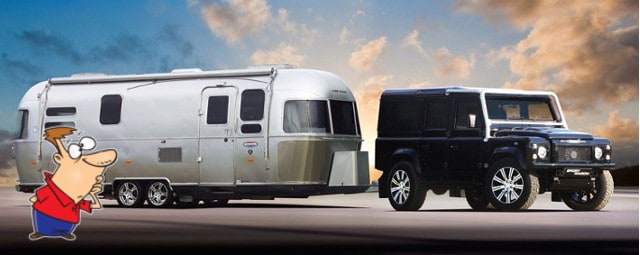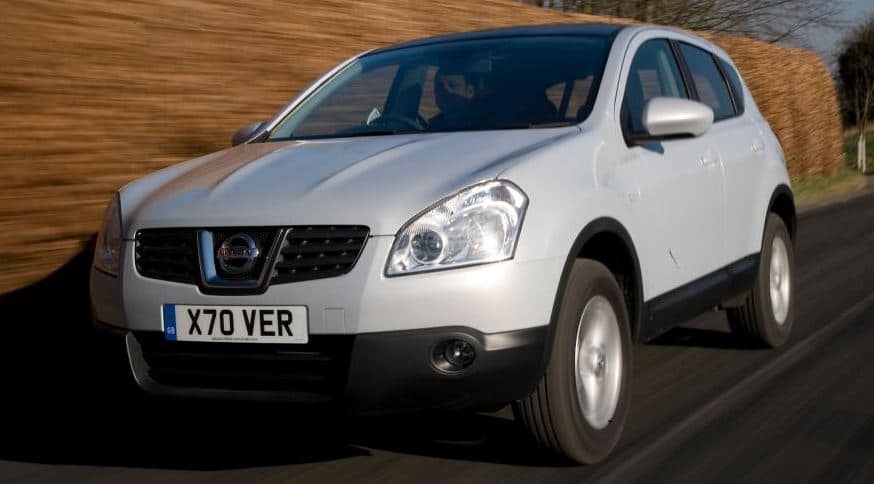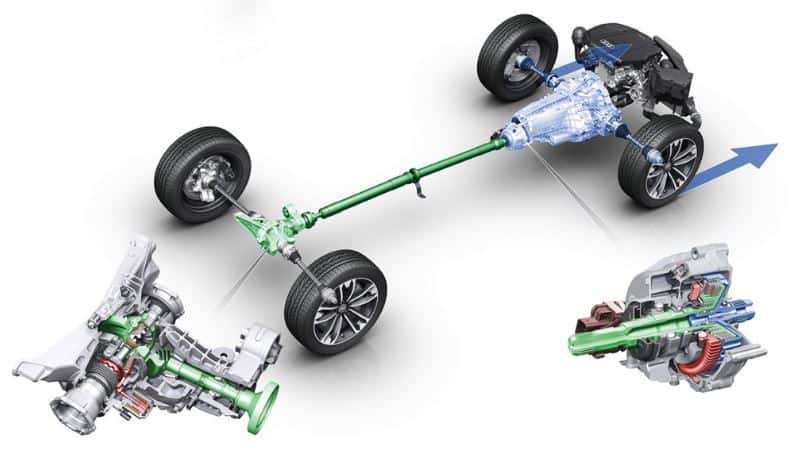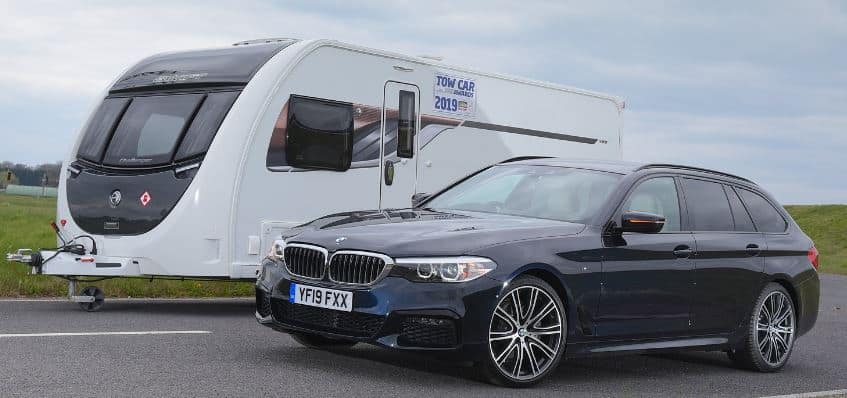
With running a small caravan site, I’ve discussed lots of topics with our guests over the years. A topic which has come up quite a few times is the debate over two-wheel-drive (2WD) vs four-wheel-drive (4WD) for towing a caravan. Before we had our road and hard-standing pitches, I used to ask on our booking form if the tow car was 2WD or 4WD. The reason I did this was I wanted to be able to predict in wet conditions if my assistance was likely to be required. I will usually end up having the conversation with our guests on 2WD vs 4WD when they were considering changing their tow car or going for a larger/heavier caravan.

In most cases, with a 4WD/AWD car, you will have more traction. However, that’s not always the case. More on that below. However, the trade-off with more traction from a 4WD/AWD is reduced efficiency.
Hence, typically a 2WD tow car will return higher miles per gallon (MPG) than a 4WD. So that’s typically the trade-off, better traction for a lower MPG.
But again, that’s also not always the case. So how do you choose the best option for you?
One of the first topics I want to discuss in this post is about the different types of 4WD drive cars. You see, there are actually a number of different 4WD systems fitted to cars suitable to tow a caravan.
They each provide different benefits and drawbacks.
For instance, our current tow car is a first-generation Nissan X-Trail with a 4WD system. However, its not the same type of 4WD drive system you would find fitted to, say, a Land Rover.
Furthermore, I own a Subaru Impreza, that also features an all-wheel-drive (AWD) setup, which again is actually different to most 4WD systems.
Therefore, the first thing I want to discuss before you consider if a 2WD vs 4WD tow car is more suitable for you is what are the differences between the different 4WD and AWD systems.
Disclaimer: Hey! By the way… any links on this page that lead to products on Amazon or Caravan Guard are affiliate links, and I earn a commission if you make a purchase, with no additional cost to you 🙂
- Dissolves waste and removes odours naturally and has delightful mild fragrance
Want To Visit Horton Common? – Book Here
Table of Contents
Temporary 4WD, Permanent 4WD and AWD Tow Cars
There is a trend in the UK car market which has been growing over the last decade. Put simply, people like compact SUVs (Sports Utility Vehicles).
Now, a Sports Utility Vehicle is really American terminology, but its now being used more and more in the UK to brand/market these vehicles.
However, they also go by another name, ‘Crossovers’. Autotrader describes a Crossover as the following:
“Crossovers generally mix the practicality of a hatchback, with SUV styling, meaning increased ride height, better visibility and ease of access, with relatively lightweight, relatively small and economical engines, and a price not much higher than a hatchback.” – Autotrader

A lot of our guests who turn up to Horton Common towing a caravan do so using a compact SUV/Crossover vehicle.
What is important to note about these vehicles is though they may have the appearance of a 4WD vehicle, in many cases, they are offered as a cheaper 2WD drive option.
I’ve spoken to guests in the past who actually thought they had purchased a towing car with 4WD capabilities, only to find out their car was the 2WD variant.
Temporary 4WD Systems – How They Work
If a particular Compact SUV/Crossover is offered with an optional 4WD system, its highly likely to be a temporary 4×4. For instance, our Nissan X-Trail features a temporary 4WD system.
There is a switch on the dashboard to select between 2WD and Auto 4WD. What that means is the car only engages 4WD when front-wheel slip is detected.
So say, for instance, I’m pulling away from a set of traffic lights in wet/icy conditions, or I’m driving over muddy ground. The rear wheels will only receive power from the engine once the front wheels start slipping.
Now, technically there is a ‘lock’ option for the 4WD on the car. However, this is not really suitable for full-time driving.
Due to the way temporary 4WD systems are designed, its only suggested to use the lock function up to a maxium speed of 30mpg. Using the lock function beyond this speed can potentially damage the 4WD system.
Where it can get confusing is with car manufacturers such as Audi and VW. Audi has been producing their 4WD systems (Quattro) since the 1980s.
And while all the original Audi Quattro systems were permanent 4WD, to increase the efficiency of their cars and improve MPG figures, Quattro cars are now a mixture of temporary and permanent 4WD systems.

The same goes for VW (who own Audi) and their 4Motion 4WD systems.
While you can purchase a Golf, Passat, Tiguan and Toureg all with 4Motion 4WD systems, there are actually different 4WD designs used across the range of VW cars with ‘4Motion’.
However, the most common design of 4Motion used today is demonstrated in the video below, which is a temporary 4WD system.
It uses an electronic clutch which provides power to the rear wheels when required. And pretty much all cars with temporary 4WD systems are based on a similar setup.
That includes the Mercedes 4Matic and BMW XDrive systems.
Many other tow car manufacturers, such as Ford, will describe their temporary 4WD systems as ‘intelligent AWD’.
Manufacturers such as VW, Audi, BMW and Mercedes use specific marketing terms to identify their vehicles with 4WD systems.
Other manufacturers such as Ford, Vauxhall, Kia, Hyundai and many more just use the acronym ‘4×4’.
Permanent 4WD Systems – How They Work
As stated above, with a temporary 4WD system the rear wheels are only engaged when front-wheel slip is detected.
These systems often use an electronically activated clutch in the rear differential to control when/if power is sent from the engine to the rear wheels.
Essentially with cars which feature permanent 4WD systems, there is no electric clutch on the rear differential. Its just a permanent connection from the main engine clutch to the front and rear wheels of the vehicle. A permanent 4WD car that you will be familiar with is the original Land Rover Defender.

The Land Rover Defender is the most commonly known example in the UK of a tow car with a permanent 4WD system: Image – Amazon.co.uk
A vehicle with a permanent 4WD system also often comes with the ability to lock the front and rear differentials (axles).
Now, being able to lock the differentials on a car towing a caravan is not going to be something you would commonly need/want to do.
Granted, if you were stuck in really deep mud/snow, it could come in handy. However, its unlikely you would need the ability to ‘lock a diff’ on your average trip out with the caravan.
If you’re curious how having locking differentials on a permanent 4WD system can help, this quick video does a good job of explaining its benefits.
You will only find permeant 4WD drive systems typically on the largest tow cars available. Furthermore, its getting less and less common for new cars to be developed with permanent 4WD due to the impact on efficiency (lower MPGs).
There are a couple of reasons why cars with permanent 4WD systems return lower MPGs, beyond the generally high vehicle weight.
The actual weight of the permanent 4WD systems with locking diffs is typically quite a bit heavier than a temporary 4WD system.
Furthermore, as all four wheels are been driven all the time, the engine is under more load. Hence uses more fuel and returns a lower MPG.
Symmetrical AWD Systems – How They Work
So the last system that I want to reference is the symmetrical AWD systems found in Subaru’s.
As stated above, I own a Subaru Impreza with AWD, though I don’t use it for towing. I own it, as living on a hill in winter can create some challenging weather conditions, and its fun to drive.
While an Impreza can be used for towing, more commonly, its a Subaru Outback, Legacy or Forester, which will be seen towing a caravan.
The symmetrical AWD system fitted to Subarus is a version of a permanent 4WD system.
However, its different to other permanent 4WD systems. The video below explains why. Though I honestly don’t expect most people reading this to be ‘nerdy’ enough to actually want to watch it.
2WD vs 4WD and Miles Per Gallon (MPG)
Ok, let’s now discuss efficiency, and how much petrol/diesel your chosen 2WD or 4WD car is likely to use while towing a caravan.
First off, ignore the quoted MPG figure for any 2WD or 4WD car when it comes to towing, its not applicable.
The additional weight of the caravan and the air resistance of towing a caravan is going to dramatically impact your car’s MPG. Its a similar scenario when it comes to electric tow cars.
Though obviously, in that case, its not how quickly you are burning petrol/diesel, its about how far you can go on a charge.

What I want to discuss here is the differences in efficiency between 2WD and 4WD tow cars themselves. In other words, will you use more petrol/diesel running a 4WD car over a 2WD car?
The simple answer is yes. However, how much more will depend on the particular 4WD system used in the tow car. For instance, a temporary 4WD system is operating most of the time in 2WD.
So the actual load on the engine is very similar to a standard 2WD car. However, a car with a temporary 4WD system its carrying more weight than a car with just 2WD. Hence a lower MPG, but maybe only slightly lower.
Cars with permanent 4WD/AWD systems are likely to be heavier again on a like-for-like basis to a temporary 4WD system in a tow car of a similar size.
Therefore, its likely cars with temporary 4WD will return a better/higher MPG than a car with a permanent 4WD/AWD for a car of a similar size.
However, cars with permanent 4WD/AWD are generally more capable of getting the car and caravan out of ‘sticky situations’. So its a trade-off/compromise.
In the conclusion below, I’ll discuss when I think that trade-off is worth it.
Traction Is Mainly About Your Tyres, Not 2WD VS 4WD
The main reason most caravanners will be debating the pros and cons of a 2WD v 4WD tow car is around the improved traction of a 4WD vs the higher MPG of 2WD.
As I’ve discussed above, any type of 4WD system will indeed likely lead to a lower MPG figure compared to a 2WD tow car.
How significantly the MPG figure will be affected will depend on the particular type of 4WD system, and the additional weight of that system etc.
However, there is a general presumption that a 4WD tow car will provide more traction than a 2WD tow car.
Well, that’s not necessarily the case. Yes, two cars with the same tyres, the one with the 4WD system, will have more traction.
But what if the two cars don’t have the same tyres? What if the 2WD car has season-appropriate/high-quality tyres and the 4WD car doesn’t?
Well, the video below will show you, and you may be surprised by the results:
Now, granted, you may have no interest in towing with your caravan in the winter months.
However, I know from speaking with our guests that many caravan owners consider a 4×4, so its generally a safer car to use in the winter months as a stand-alone car.
What the video above shows is that on every metric in terms of traction, handling and braking a good set of appropriate weather tyres on a 2WD car will outperform a 4WD car with inappropriate tyres.
I’ve previously written another post on what I think are the best tow car tyres. While we do get snow in the UK is not a common occurrence. Potentially even less likely going forward with climate change.
Therefore, I believe most tow cars would be best served with a decent set of all-season tyres. I changed my car’s tyres over to a set of Michelin CrossClimate.
The difference in braking and handling in all conditions is noticeable over the budget summer tyres I previously had.
Conclusions On 2WD/FWD vs 4WD/4×4 For Towing A Caravan
Ok, so what are my final thoughts on this 2WD vs 4WD towing debate?
First and foremost, make sure you are putting decent quality/weather-appropriate tyres on any car.
As shown in the video above, choosing to spend the money on a 4WD over a decent set of weather-appropriate tyres is a false economy.
After reading the summary below, you may also be interested in my post on what I think are the best cars for towing a caravan.
Tow Car & Caravan Weights
Secondly, the weight relationship between your car and the caravan is very important. You want the weight of your caravan to be at least a 1:1 ratio with your tow car.
There is also the ‘85% rule’ between the tow car and caravan. However, that’s not actually a legal requirement, hence not an actual rule.
Modern cars and caravan stabilisers give you a better chance of keeping the caravan under control. However, you still don’t want to be towing a caravan heavier than your car.
It increases the chance of the caravan dictating where the car goes on the road. The ‘tail wagging the dog’ scenario. Heavy tow cars are typically 4WD, but that’s not always the case.
Temporary 4WD With Good Tyres
All things being equal, a decent set of weather-appropriate tyres on a car with a 4WD system will make your life easier when towing.
With 4WD pulling away from traffic lights and accelerating, you are less likely to lose traction.
Likewise, going up a steep hill in wet/icy conditions will be less stressful with 4WD. In most instances, I believe a tow car with a temporary 4WD system will be the best option.
They provide a good blend of improved traction with a minimal impact on MPG.
However, if you do like going winter or off-grid camping, then upgrading to a tow car with a permanent 4WD system may suit you better.
Thanks for reading. I hope you found the information on the different types of 4WD tow cars interesting.
So while a tow car with 4WD can be the preferable option, for traction, first and foremost, you want to focus on your tyres.
Also, having a set of quality grip mats in your caravan is a good idea. In the future, I hope you consider coming to visit us here at Horton Common caravan site. 🙂
Want To Visit Horton Common? – Book Here

